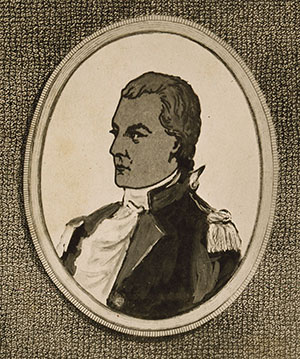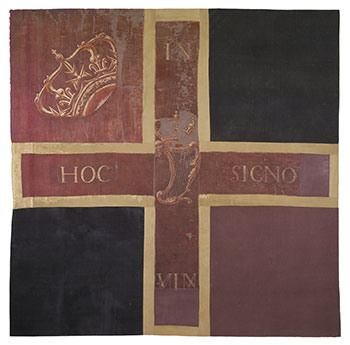The Dillon regimental colour
Published in Artefacts, Issue 3 (May/June 2020), Volume 28By Lar Joye

Above: Major-General Count Arthur de Dillon, executed by the French government in 1794.
The tradition of Irish service with the French army dates from 1615 but the era of the ‘Wild Geese’ regiments is from 1688 to 1791. The Williamite Wars (1688–91) caused the first 5,000 Irish recruits to arrive in France and these formed the basis of the famous Irish Brigade, consisting of five Irish regiments. One of these was the Dillon Regiment led by Theobald, 7th Viscount Dillon of Costello-Gullen, and over the next 100 years his family and the regiment fought in Italy, Spain, Scotland, Germany, the West Indies and, finally, during the American Revolution at the siege of Savannah, Georgia. As explained by Stephen McGarry in the previous article, the most famous battle in which the Irish Brigade and the Dillion Regiment fought was the Battle of Fontenoy on 11 May 1745. This engagement was part of the War of Austrian Succession (1740–8), a Europe-wide conflict over the right of Maria Theresa to be queen of Austria, an argument she won in the end.
 Colonel James Dillon was killed leading his regiment, and according to Dillon family tradition the flag pictured here was carried at the battle by the Irish Wild Geese. In the days of muskets and cannons, regimental colours became a rallying point in the chaos of battle, and their loss or capture was the ultimate humiliation for an infantry officer. Similarly, artillery officers treated their cannons in the same way, regarding destroying them as better than having them captured. What is interesting about this flag is the symbols that are used on it. The Irish regiments owed their allegiance to the deposed King James II and his descendants, wearing red uniforms rather than the blue or white of the French army. The flag is based on those carried at the Boyne and Aughrim, with a harp, the cross of St George, the Stuart crown in one corner and the motto In hoc signo vinces (‘In this sign conquer’).
Colonel James Dillon was killed leading his regiment, and according to Dillon family tradition the flag pictured here was carried at the battle by the Irish Wild Geese. In the days of muskets and cannons, regimental colours became a rallying point in the chaos of battle, and their loss or capture was the ultimate humiliation for an infantry officer. Similarly, artillery officers treated their cannons in the same way, regarding destroying them as better than having them captured. What is interesting about this flag is the symbols that are used on it. The Irish regiments owed their allegiance to the deposed King James II and his descendants, wearing red uniforms rather than the blue or white of the French army. The flag is based on those carried at the Boyne and Aughrim, with a harp, the cross of St George, the Stuart crown in one corner and the motto In hoc signo vinces (‘In this sign conquer’).
After the French Revolution in 1789 the Dillon Regiment lost its sense of Irish identity, as it became the 87th Régiment d’Infanterie. Some soldiers transferred their allegiance to the British army, supporting the deposed French royal family, while Major-General Count Arthur de Dillon was executed by the French government in 1794. The regimental colour was presented to the National Museum of Ireland by the then Viscount Dillon with the assistance of the Military History Society of Ireland in 1950. After two years of conservation work it was placed on display in the ‘Soldiers and Chiefs’ exhibition in Collins Barracks. Today the 1,000 soldiers of the 92nd Infantry Regiment of the French Army are based in Clermont-Ferrand in France and are the last link to the former Irish regiments.
Lar Joye is Heritage Officer, Dublin Port.
















